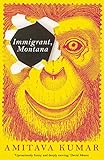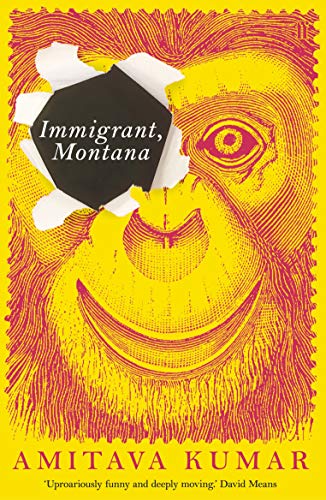Amitava Kumar tends to talk about his forthcoming novel, A Time Outside This Time, as if he’s still in the process of writing it. He says he’s “going to” try to achieve certain effects with it. He says “I will” adopt certain narrative strategies. He poses provisional questions: “What form do I give,” he asks, to the story he wants to tell?
It’s a curious tic but, given the novel’s subject matter, it’s not surprising. A Time Outside This Time, set primarily in the first half of 2020, is about the global proliferation of fake news and the writer’s obligation to combat it. Rather than examine the vagaries of our moment from a retrospective distance, the novel allows itself to be shaped by them, navigating events—the Covid-19 pandemic, the Black Lives Matter protests, the last breaths of the Trump presidency—as they unfold. No wonder Kumar describes his novel as if he’s still writing it: the story he’s telling is still happening.
“I’m going to put down the news,” Kumar says via Zoom from a hotel room in Sewanee, Tenn., where he’s teaching a class at the Sewanee Writers’ Conference. “I will put everything down as it is occurring—there will be an immediacy—but also I’m doing something that is artistic, or cunning.”
The book’s protagonist is a writer much like Kumar who is at work on a novel much like A Time Outside This Time. When readers first encounter the narrator, Satya, he’s staying at an artist’s retreat in what appears to be Lake Como, Italy, near a mansion owned by George and Amal Clooney. (The Clooneys’ Lake Como house is becoming something of a fixture of the literary landscape. It also figured briefly in Ayad Akhtar’s 2020 novel Homeland Elegies.) Satya describes his work in progress as a “report from the world of #fakenews”—a book “made up entirely of rumors. A compilation of fatal falsehoods.”
What follows is a pastiche of memoir, journalism, and diaristic note taking. Satya thinks back to his childhood in India, recounts two reporting assignments during which he was fed deceptions, and, in a long chapter of numbered fragments, gathers anecdotes and ephemera about literature, history, and political misinformation, juxtaposing images, quotes, and tweets from @realDonaldTrump.
Satya’s goal, he says, is to “slow-jam” the news (a phrase taken from a recurring segment on The Tonight Show Starring Jimmy Fallon). By lingering on current events and framing them in surprising contexts, he aims to “perform the news so that it reveals its inner self.”
“Why,” Satya asks, “must one slow-jam the news? Because all that is new will become normal with astonishing speed.”
With this multimodal approach, Kumar, 58, feels he’s landed on his literary form. But it took him a while to find it. He began his career in academia, arriving in the U.S. from India in the late 1980s to pursue a master’s in English at Syracuse University. After completing a PhD in comp lit at the University of Minnesota, he held teaching posts at the University of Florida, Penn State, and elsewhere.
But Kumar found the language of scholarship constricting. “I was generating writing that had the consistency of freshly mixed cement,” he says. “I wanted to do something more inventive.”
 Kumar’s bibliography is, like A Time Outside This Time, a mix of reportage, cultural criticism, and fiction. His books include Passport Photos, a genre-blending investigation of postcolonialism and migration; Husband of a Fanatic, an autobiographical reflection on Hindu-Muslim relations in India; and A Foreigner Carrying in the Crook of His Arm a Tiny Bomb—partly an account of two suspected terrorists and partly a study of 9/11’s effect on art and culture.
Kumar’s bibliography is, like A Time Outside This Time, a mix of reportage, cultural criticism, and fiction. His books include Passport Photos, a genre-blending investigation of postcolonialism and migration; Husband of a Fanatic, an autobiographical reflection on Hindu-Muslim relations in India; and A Foreigner Carrying in the Crook of His Arm a Tiny Bomb—partly an account of two suspected terrorists and partly a study of 9/11’s effect on art and culture.
 Kumar’s breakout novel, Immigrant, Montana, published in 2018, laid the groundwork for A Time Outside This Time; it too intersperses its narrative with essayistic digressions. The New Yorker called the book, somewhat perplexingly, a “nonfiction novel” and compared it to the work of autofiction eminences Ben Lerner and Sheila Heti.
Kumar’s breakout novel, Immigrant, Montana, published in 2018, laid the groundwork for A Time Outside This Time; it too intersperses its narrative with essayistic digressions. The New Yorker called the book, somewhat perplexingly, a “nonfiction novel” and compared it to the work of autofiction eminences Ben Lerner and Sheila Heti.
Kumar isn’t quite comfortable with the term autofiction. (Novelists charged with writing it tend not to be.) “What is usually presented as autofiction is narrowly a story of the self,” he says. “I wanted to mess with that idea. I’m not someone who is describing getting up from this table, making tea, going into the bathroom, coming out, making a call to my wife.”
 Though Satya does provide reports from the interior—about his fitful work on his manuscript, his conversations with his fellow artists in residence, his reading of Orwell’s 1984, and his life with his wife and child—his focus for the most part is on the avalanche of fake news engulfing the U.S. and India. As Covid-19 runs rampant, Trump minimizes the crisis and then touts the benefits of hydroxychloroquine. In India, rumors spread that the virus can be detected by satellites or eradicated by candles, and baseless accusations lead to the lynchings of Muslim men. In an afterword, Kumar cites Trump’s claim that he won the 2020 election “by a lot.” He need not spell out what that lie led to.
Though Satya does provide reports from the interior—about his fitful work on his manuscript, his conversations with his fellow artists in residence, his reading of Orwell’s 1984, and his life with his wife and child—his focus for the most part is on the avalanche of fake news engulfing the U.S. and India. As Covid-19 runs rampant, Trump minimizes the crisis and then touts the benefits of hydroxychloroquine. In India, rumors spread that the virus can be detected by satellites or eradicated by candles, and baseless accusations lead to the lynchings of Muslim men. In an afterword, Kumar cites Trump’s claim that he won the 2020 election “by a lot.” He need not spell out what that lie led to.
Satya’s question is how fiction can counteract fake news. Both, after all, are deviations from the truth. His answer is that fiction seeks to expand the mind while fake news seeks to shrink it. “Unlike literary fiction,” he says, “what we call fake news most deeply conforms to a popular prejudice. It is formulaic, often sentimental, and has about it a quality of sickening repetitiveness.”
Kumar elaborates. “The state is a writer of bad fiction,” he says. Its heroes and villains, he adds, tend to be what E.M. Forster called “flat” rather than “round” characters. “They would be shut down in a fiction workshop. My fiction must be more protean, more imaginative, more accurate than what the state produces.”
Having grown up in India and written about that country extensively, Kumar observed the effects of mass deception and demagoguery before the rise of Trump. “The sun rises earlier in India every day,” he says. “What happens in America is going to follow exactly what happens there.”
While his form is fiction and his subject is fake news, there’s nothing imaginary, for Kumar, about the consequences of misinformation—of mob mentality and media subservience and historical erasures and revisions. At one point during this conversation, he picks up the galley of his book and reads aloud a passage:
“You notice one fine day that all the signs on the road have changed. Your town has a new name. Dogs have grown fat on flesh torn from corpses lining the street where you grew up. The beautiful tree outside your window is dead, has been dead for a long time, and has, in fact, just now burst into flames.”
“None of this, unfortunately,” Kumar says, “comes from my imagination.”
Bonus Links:
—Amitava Kumar, Collector of Writerly Advice Distilled Into One Line
—Geopolitics and Sex, Geography and Desire: On Amitava Kumar’s ‘Immigrant, Montana’
This piece was produced in partnership with Publishers Weekly.














